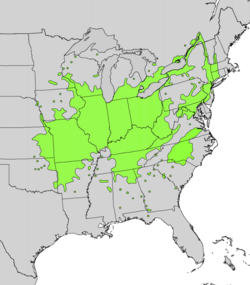Biology:Staphylea trifolia
| Staphylea trifolia | |
|---|---|

| |
| Scientific classification | |
| Kingdom: | Plantae |
| Clade: | Tracheophytes |
| Clade: | Angiosperms |
| Clade: | Eudicots |
| Clade: | Rosids |
| Order: | Crossosomatales |
| Family: | Staphyleaceae |
| Genus: | Staphylea |
| Species: | S. trifolia
|
| Binomial name | |
| Staphylea trifolia | |

| |
Staphylea trifolia, the American bladdernut,[2] is native to eastern North America, from southern Ontario and southwestern Quebec west to Nebraska and Arkansas, and south to Florida. It is sometimes used as an ornamental plant.
It is a medium-sized shrub growing to 3.5 m (11 ft) tall.[3] Its growth rate is medium to fast.[citation needed] The leaves are opposite and divided into three leaflets, each leaflet 4.5–13 cm (2–5 in) long[4] and 5 cm (2 in) broad, with a serrated margin.[3] The leaves are bright green in the spring, turning dark green in the summer. S. trifolia produces pendant white flowers in spring, which mature into bladder-like, teardrop-shaped fruits that contain 1-3 brown popcorn-like seeds.[3] Some sources consider these "nuts" to be edible. [5]
References
- ↑ Botanic Gardens Conservation International (BGCI).; IUCN SSC Global Tree Specialist Group (2018). "Staphylea trifolia". IUCN Red List of Threatened Species 2018: e.T135957125A135957127. doi:10.2305/IUCN.UK.2018-2.RLTS.T135957125A135957127.en. https://www.iucnredlist.org/species/135957125/135957127. Retrieved 20 November 2021.
- ↑ "Staphylea trifolia". Natural Resources Conservation Service PLANTS Database. USDA. https://plants.usda.gov/core/profile?symbol=STTR. Retrieved 1 December 2015.
- ↑ 3.0 3.1 3.2 Template:Missouri Plants
- ↑ Brouillet, Luc (2014), "Staphylea trifolia", in Flora of North America Editorial Committee, Flora of North America North of Mexico (FNA), 9, New York and Oxford, http://www.efloras.org/florataxon.aspx?flora_id=1&taxon_id=
- ↑ "Staphylea trifolia". https://plants.ces.ncsu.edu/plants/staphylea-trifolia/.
Wikidata ☰ Q3496910 entry
 |


